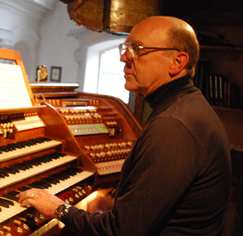In their press release introduction, printed on the back of the program, The Boston Globe is quoted as referring to the Borromeo Quartet as “Simply the best there is.” After hearing their concert on Sunday afternoon at St. Stephen’s Episcopal Church, one would have difficulty arguing with that assertion. The acoustic in the church sanctuary is somewhat lively, with slate floors, opulent stained glass windows, and brick walls, but not so lively as to blur the sound. Rather, the sound was richly blended and focused, and the acoustics emphasized the group’s superb ensemble presentation.
St. Stephen’s is first violinist Nicholas Kitchen’s home church. His parents, outstanding musicians both, still are active in the church. The instrument he played on this program is one of the charmed Guarneris, and its tone, in Kitchen’s skilled hands, was magical and brilliant. Second violinist, Kristopher Tong matched wit and charm, violist Mai Motobuchi’s playing was gallant and lilting, and cellist Yeesun Kim provided a firm and warm depth to the ensemble.
Haydn’s String Quartet in D, Op. 76/5, which opened the program, established Borromeo’s elegant side, and they played it with affectionate gusto. This is the fifth of the six quartets commissioned by and dedicated to Count Joseph Erdody and composed 1796-97. These are among Haydn’s most ambitious chamber works, deviating more than previous scores from the expected sonata form. Still this quartet demonstrates all the charm, wit and happy music that was Haydn’s best and most mature. It was also an ideal precursor to the Beethoven, which was to follow after intermission, and the next work on the program as well.
Even though Shostakovich’s String Quartet No 9 in E-flat, Op. 117, is not as intensely personal as the one in which he uses several self-quotes and his signature D-S-C-H, it is equally dramatic, and it took this reviewer on a frightful journey. It opens with an eerie sense of doom, attempts to brighten, but falls back. The second of the five movements sings of pathos with moments of counterpoint using related melodies and almost unbearable sadness. The third movement is a wild chase through dark streets, a violent pursuer close behind. In the forth movement, I felt safe, having escaped the pursuer — but only briefly. Then with vicious plucked strings there was awareness of having been wounded or having lost something in the chase. In the last movement, it seemed there were attempts to regain self-confidence, to get on with life. After the viola’s quiet, prayerful resolution, the chase music returns, and the slashing pizzicatos, even more frightful and angry than before, lead to an intense crescendo of determination. In spite of everything, Shostakovich will press on with creativity and perhaps a hint of hope. It was a stunning and vivid performance.
I cannot resist comparing the closing work, Beethoven’s String Quartet in B-flat, Op. 130, to the previous two selections. If Haydn stretched the sonata form in his Erdody quartets, Beethoven smashed it in his late quartets. Opus 130 originally ended with the “Grosse Fugue,” characterized by jolting leaps and enormous contrasts. (We will have to wait till early spring and the Borromeo Quartet’s next visit for that stunning experience.) On this occasion, we heard the alternate Finale: Allegro, slightly cheerful and more accessible. Amid with the avant-garde tonality, the violent contrasts, and the wildly innovative forms that characterize Beethoven’s last five quartets, this one has a mercurial, almost pastoral aspect to it. It is cast in six distinct movements with a pause between each.
If Shostakovich’s quartet was personal in character; Beethoven’s is even more so, but in a different way. Shostakovich is dealing more with threats from without. Beethoven is dealing with the dark, deep inner imagery of a deaf composer. Whereas Shostakovich’s music left me with vivid and dramatic visions, Beethoven’s music left me with a combination of questions and awe. This is pure music, and the music speaks of depths I doubt I will every fully comprehend.
The Borromeo gave us a sterling performance — an array of eloquence, drama and probing that demonstrates the completeness of their skill and artistry.











